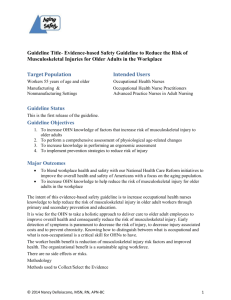Musculoskeletal and sports medicine
advertisement
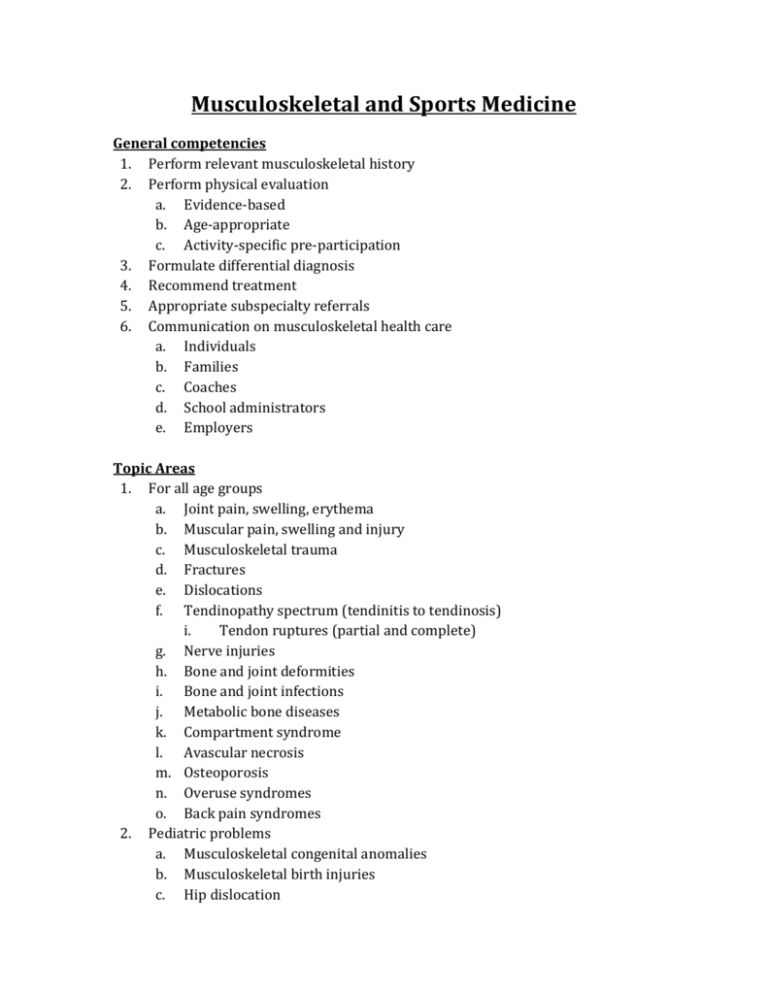
Musculoskeletal and Sports Medicine General competencies 1. Perform relevant musculoskeletal history 2. Perform physical evaluation a. Evidence-based b. Age-appropriate c. Activity-specific pre-participation 3. Formulate differential diagnosis 4. Recommend treatment 5. Appropriate subspecialty referrals 6. Communication on musculoskeletal health care a. Individuals b. Families c. Coaches d. School administrators e. Employers Topic Areas 1. For all age groups a. Joint pain, swelling, erythema b. Muscular pain, swelling and injury c. Musculoskeletal trauma d. Fractures e. Dislocations f. Tendinopathy spectrum (tendinitis to tendinosis) i. Tendon ruptures (partial and complete) g. Nerve injuries h. Bone and joint deformities i. Bone and joint infections j. Metabolic bone diseases k. Compartment syndrome l. Avascular necrosis m. Osteoporosis n. Overuse syndromes o. Back pain syndromes 2. Pediatric problems a. Musculoskeletal congenital anomalies b. Musculoskeletal birth injuries c. Hip dislocation d. e. f. g. h. i. j. k. l. m. n. o. p. q. r. Congenital hip dysplasia Legg-Calvé-Perthes disease Osgood-Schlatter disease Slipped capital femoral epiphysis “Clubfoot” (talipes equino varus) In-toeing (metatarsus adductus, tibial torsion, femoral anteversion) “Bowleg”(genu varum) and “knock knee”(genu valgum) Epiphyseal injuries (Salter-Harris classification) Transient synovitis Child abuse patterns of injury Dislocation of the radial head (Nursemaid’s elbow) Blount disease Rickets Osteogenesis imperfecta Thoracolumbar scoliosis For each topic area 1. Epidemiology 2. Anatomy 3. Pathophysiology/Etiology 4. Risk factors 5. History and physical exam 6. Diagnosic Tests 7. Differential diagnosis 8. Management 9. Psychosocial implications Highlighted teaching points 1. Anatomy a. Normal anatomy b. Normal growth and development 2. Diagnostic tests: a. Laboratory tests (e.g Joint fluid) i. Indications ii. Contraindications iii. Interpretation b. Radiology i. Radiographs ii. Magnetic resonance imaging iii. Computed tomography 3. iv. Bone scan c. Special Tests: indications and applications i. Arthrogram ii. Myelogram iii. Arthroscopy iv. Electromyography v. Nerve conduction studies Management a. Office based musculoskeletal procedures i. Joint aspirations and injections ii. Indications, limitations, contraindications iii. Informed consent b. Expected course i. With therapy ii. Without therapy c. Patient education i. Acute problems ii. Chronic problems d. Targeted pharmacologic treatment e. Supportive/corrective devices i. Braces ii. Casts iii. Splints iv. Orthotics f. Complementary and alternative modalities g. Prevention i. Pre-participation screening ii. Conditioning and training h. i. iii. Injury prevention iv. v. Physical fitness/exercise prescription Bone loss 1. Nutrition 2. Exercise 3. Pharmacology Rehabilitation Indications and components i. Physical therapy 1. Cold, heat 2. Ultrasound and phonophoresis 3. Exercises 4. Electrical stimulation (e-stim) and iontophoresis ii. Occupational therapy iii. Complementary modalities (e.g., osteopathic manipulative treatment [OMT], massage) iv. Psychosocial aspects of trauma j. Surgery and follow-up care i. Internal and external fixation devices ii. Artificial joint replacement iii. Arthroscopy k. Sport medicine specific management i. Nutrition, fluids, electrolyte and dietary supplements ii. Injury prevention 1. Discourage improper techniques 2. Rules: a. Promote rule changes b. Rule enforcement iii. Proper Equipment and maintenance iv. Tapping, strapping and bracing techniques v. Assessment of environmental safety 1. Promotion of participant and spectator safety vi. Conditioning and training techniques/principles: 1. Aerobic training 2. Anaerobic Training vii. Exercise prescription: 1. Healthy individuals: a. Account for age and sex 2. Chronic illnesses: a. Diabetes b. Hypertension c. Congestive heart failure d. Asthma e. Chronic obstructive pulmonary disease 3. Pregnancy 4. Physically or mentally challenged individuals 5. Patients with various cardiovascular conditions a. Arrhythmias b. Risk for sudden cardiac death c. Hypertrophic cardiomyopathy 4. Sports medicine education: a. Patients, families, complementary health professionals, coaches and school administrators b. Athlete as a patient i. Team physician 1. Importance of their presence 2. Role of medical directors 3. Role of on-site medical care for mass sporting events ii. Acute Injuries 1. Cervical spine injury a. Evaluation b. On field management c. Transport 2. Concussion/Traumatic Brain Injury a. Evaluation b. On field management 3. Intracranial hemorrhage a. Evaluation b. On field management c. Transport 4. Severe Fractures and Dislocations a. Evaluation b. On field management c. Transport iii. Sport Specific Consideration for: 1. Ill athletes 2. Injured athletes 3. Specific athlete groups a. Pre-adolescent Athletes b. Adolescent Athletes c. Female Athletes d. Geriatric Athletes e. Physically challenged Athletes f. Student Athletes g. Recreational Athletes h. Athletes with chronic disease iv. Rehabilitation 1. Oversight 5. 2. Return to play decision making v. Exercise induced asthma vi. Cardiac screening 1. Exercise related cardiac problems Exercise related psychosocial problems a. Exercise addiction b. Performance enhancing drug abuse c. Social pressures on athletes i. To participate when injured d. Performance pressures i. Common sources ii. Methods to alleviate e. The intermittent exerciser f. Unmet/unrealized expectations: i. Psychosocial implications ii. Sources of aid g. Alcohol and illicit drug use and abuse h. Eating disorders References: 1. American Academy of Family Physicians. (2008). Recommended Curriculum Guidelines for Family Medicine Residents, Musculoskeletal and Sports Medicine (Reprint No. 278), Leawood, Kansas.
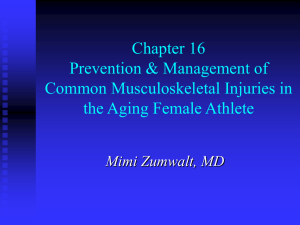
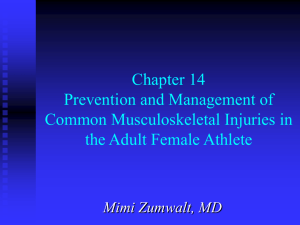





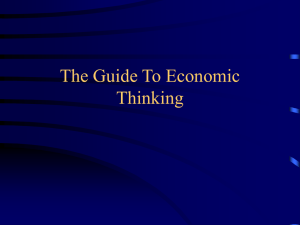
![CSB_InjuryPredictionVariables_Abstract_[3]_10](http://s3.studylib.net/store/data/006832869_1-51ab087a6bf0540639c74a0864a8c85c-300x300.png)
